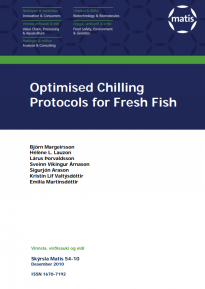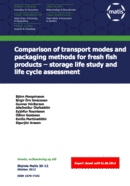Application of Appropriate Technology for Refrigerated Road Transport
Technology solutions associated with controlling food loss and waste during refrigerated transport centre on proper use of available technology including temperature control, packaging and maintenance. To ensure the quality of fresh seafood the continuous cooling of the goods is essential.
Pre-cooling
Pre-cooling
Prior to loading, the container should be pre-cooled and the loading should proceed quickly. Pre-cooled foodstuffs should be loaded under temperature-controlled conditions wherever possible.
Palletized loading and the formation of a scaled connection between the vehicle and cold or chill store are both helpful in keeping the temperature rise at this stage to a minimum.
An example in practice can be found at the Perishable Centre at Keflavik Airport (Iceland), which is equipped with a new pre-cooling system. The system produces an air stream which allows the ambient air of the refrigerated warehouse to be circulated through the pallets. This means that the cool air reaches the interior areas of the pallets in the shortest possible time. This process greatly reduces the cooling down period. The accelerated cooling slows down spoilage and thus increases the possible storage period of products.
Packaging
Packaging
Packaging the product in a master carton will reduce the risk of temperature rise during handling outside a refrigerated space. Use well insulated fish boxes. Expanded polystyrene (EPS) boxes are preferred. Ice packs can be added before packs are closed. Use as large packaging units as possible bearing in mind the client‘s requirements.
The size of a pack affects the speed at which it warms; the smaller the pack the greater is its surface area in relation to its volume and the quicker it warms. Increased knowledge on the advantages and disadvantages of the packages used for this fresh fish export will facilitate the selection of packages and improve the quality and storage life of the products.
Less insulated fish boxes are preferable when the ambient temperature is lower than the product temperature.
Proper Storage of Product
Proper Storage of Product
To ensure temperature uniformity in a load of chilled foodstuffs, relatively high rates of continuous air circulation and high levels of temperature control are necessary. Careful stowage within the vehicle or container will therefore be needed to achieve a free flow of cooling air around the cargo.
Key Publications
Optimized Chilling Protocols for Fresh Fish The overall aim of the optimized chilling protocols is to describe the most effective chilling methods for any stage in the food supply chain with emphasis on whitefish. | |
Comparison of Transport Modes and Packaging Methods for Fresh Fish Products The aim of the project was to compare alternative packaging methods of fresh fish loins to the traditional packaging. |
More Resources
More Resources
31 October 2023













